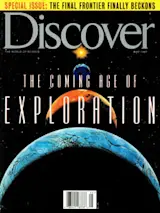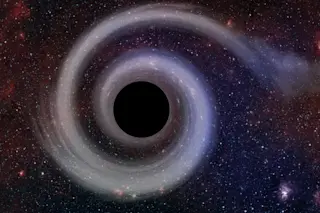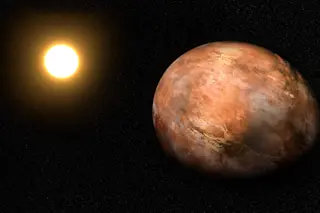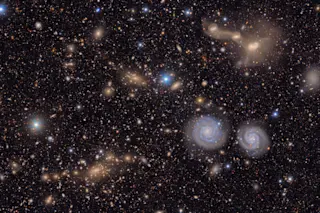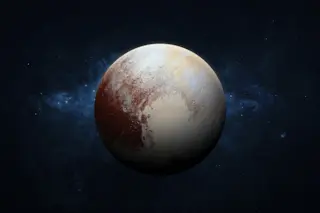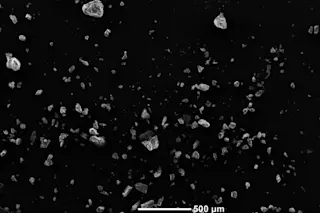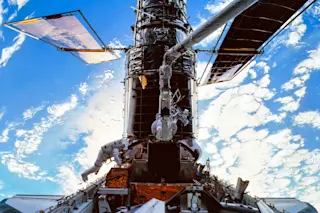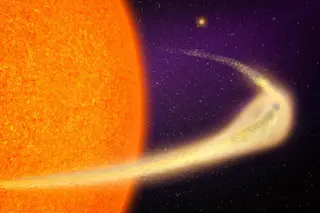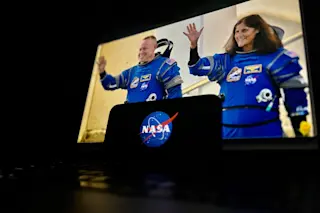The sci-fi lure of mars is as strong as ever, the fantastic vision still, after all these years, so very easy to conjure up: You breakfast under a pale pink sky dotted with two tiny moons. Finish up, step into a plastic-domed greenhouse, and gather a few vegetables for lunch. Then drive out to a craggy red hilltop. Later, drill for water or poke around in the frozen rusty soil. Head back to base. Record your day’s discoveries. Check your E-mail. Think about dinner.
No one believes in this vision more passionately than Robert Zubrin. Since 1990 the former Martin Marietta engineer has been tirelessly promoting his Mars Direct plan, which is aimed at getting humans to Mars for a reasonable price. The key lies in extracting oxygen from abundant Martian carbon dioxide to make not only rocket fuel but air and water. The chemical synthesis is kid’s stuff, says Zubrin. It seems like a magic trick because you’re making fuel out of the air. But German V-2 crews in the woods used to make liquid oxygen out of the air to prepare their vehicles for launch.
Perhaps that particular bit of imagery is not the most persuasive Zubrin could call forth, but his point is well taken. And the report last August that a Martian meteorite bears possible traces of primordial life hasn’t hurt his cause. For two decades, ever since researchers concluded that Martian soil samples showed no indisputable signs of life, missions to the Red Planet--and most particularly manned missions--have been hard to sell. Now, suddenly, there is an opening. Going to Mars to look for life is a very clear goal, and it is a very compelling goal, says David Kaplan, Mars mission design specialist at the NASA Johnson Space Center. I think the announcement of this evidence has helped focus a vision for what NASA should do in the next several years. Until you go to Mars and pick up a fossil, the evidence from meteorites is compelling but not conclusive.
Even if Mars should ultimately prove barren, the planet still offers profound mysteries to explore. Twisted channels scarring its surface betray a time, eons ago, when rushing water carved through the Martian soil. Vast red deserts sweep up into mountain ranges that dwarf the Rockies. (The extinct Martian volcano Olympus Mons is three times as high as Mount Everest and is topped with a caldera the size of Oahu.) With a roughly 24-hour day, at least two and maybe four seasons, abundant carbon, and a thin, cold atmosphere of carbon dioxide, Mars isn’t all that different from Earth. One of the fundamental reasons we must go to Mars, says Kaplan, is that Mars and Earth seem to have been very alike in their distant pasts. The question is, What happened to Mars?
Already two small spacecraft are heading for the planet to collect data about its weather and topography. The missions were planned long before the news of the Martian meteorite fossils broke, but they will help collect information necessary to send humans to Mars, says Kaplan. The first, the Mars Global Surveyor, was launched November 6 and is slated to arrive on September 15, at which point it will circle the planet, mapping the surface through remote sensing and perhaps incidentally identifying suitable landing sites. The second mission, the Mars Pathfinder, was launched on December 4 and is scheduled to land on July 4. On board is Sojourner, a rover the size of a shoe box that will roam around for one to four weeks gathering data on Martian soil.
Current plans call for additional robotic probes before a sample- return mission is launched in 2005. At that time a rocket will land one or two small rovers to collect rocks, pebbles, and soil; the vessel will also be equipped to extract oxygen from Martian CO2. This oxygen will be used to light the propane propellant to fuel the return journey and thus will provide a crucial test of whether Martian resources can indeed be exploited for making fuel.
A human mission could follow in as little as four years but more likely ten. The stakes are high: crews will probably need to spend some 500 days on the Martian surface, and travel time each way will be about six months. That’s two and a half years--a long time to depend on a life- support system.
NASA hasn’t committed itself to human footprints on Mars, but it certainly hasn’t been ignoring the possibility either. Just to get an idea of what might work, mission designers have developed a scenario that, says Kaplan, is considerably more cautious than Zubrin’s. But it will still take advantage of Martian CO2 for local use--most important, for fueling base operations and for fueling the liftoff from Mars.
The mission might work like this: In 2016 (to pick a conservative date) three robotic heavy-lift launches depart Earth to lay the groundwork for a Mars base. The first to launch is the Earth Return Vehicle (ERV)--a rocket fully equipped with fuel for getting to and from Mars, as well as food, water, and other supplies for the journey back. After reaching Mars, the ERV will remain in orbit, awaiting the crew’s departure. The second launch, the Mars Ascent Vehicle (MAV), will carry hydrogen and a nuclear- powered chemical plant to the surface; upon landing, it will unload the plant, which in turn will transport itself to a location about a kilometer away. There it will begin to suck oxygen out of Martian CO2; it will store the oxygen in tanks and mix the carbon with hydrogen to make methane, a high-energy rocket fuel. Once the crew arrives, the reactor will also be used to derive air and energy for base operations. The third launch carries a habitation module intended for placement near the MAV on the Martian surface and holding food, water, laboratory equipment, and other supplies for the crew’s 500-day stay. All three of these vessels will economize on fuel by taking a slow, ten-month trajectory to Mars.
Two years later, in 2018, a fourth heavy-lift spacecraft is deployed, carrying the crew in a habitation module just like the one sent in 2016. It, too, carries enough supplies for 500 days on Mars, as well as some scientific equipment. This craft, however, takes the fast, six-month route to Mars to minimize the crew’s long-term exposure to zero gravity and space radiation.
The crew’s living quarters will be a module roughly the size and shape of a two-story, 1,500-square-foot tuna can. Crew cabins, kitchen, and command station will be on the top story; the lower floor will house cargo and a small laboratory. During the outbound flight, the crew will have plenty of time for reading books from the computer library or communicating with Earth through either voice mail or E-mail. Their diet will be a far cry from the powdered food and Tang that fed the first astronauts to set foot on a foreign world, some 50 years earlier. Whole food--with high water content--will help reduce the amount of water needed for the mission.
Shortly after the crew lifts off from Earth, a second ERV and MAV are launched. These spacecraft will get to Mars four months after the first crew arrives; they are the infrastructure for the second crew’s arrival, in 2020. But they are also the first crew’s backup getaway car. If the first crew happens to land far from the first MAV and habitation module, this second MAV can be redirected to wherever they landed.
If all goes well, base construction begins: connecting the arriving habitation module with the one already there; setting up solar panels for a backup power supply; clearing terrain for roads and future launching and landing pads. Although the crew can live off the supplies shipped ahead in the habitation module, they will try to raise plants in Martian soil, either in their quarters under artificial light or outside in a plastic-domed greenhouse. And while the crew will live in the module, they might try building brick chambers made from Martian basaltic rocks. Such shelter would be an important feature for any long-term settlement. Making plastics and ceramics is also possible since Mars, unlike the moon, possesses abundant carbon and other minerals.
But the heart of the mission will be exploring and scouring the surface for fossils and mineral resources. There will be a pressurized rover for carrying four people on forays three to four weeks long, and possibly a few light trucks. All will run with chemical combustion engines, using fuel made from CO2.
After some 500 days on Mars, the crew departs in the now fully fueled Mars Ascent Vehicle, leaving behind their habitation module as a base for the next crew. The MAV docks with the ERV that has been orbiting Mars throughout the mission; the crew then heads for home. By this time, the second crew’s ERV and MAV will have arrived. Within a few months, the second crew members themselves will follow, passing the returning first crew en route. Such missions, launched at two-year intervals--since that’s how often the relative positions of Earth and Mars offer an economic flight path--will lay the foundation for permanent settlement.
Even if exploiting Martian CO2 for fuel and air proves easy, there are other obstacles. A reliable life-support system, of course, is crucial. Altering Martian soil to support plants from Earth may be a solution. These plants, nourished by human waste, could help recycle air and water in a closed system. Already NASA has successfully completed a month-long experiment using plants to recycle air and water in a sealed chamber containing four researchers.
But one of the greatest risks is cosmic radiation: high-energy particles streaming through space that can bombard cells and rewrite DNA. Crews orbiting Earth are above our planet’s protective atmosphere, but they are still shielded by its magnetic field. Even on Mars, astronauts would get some protection from the thin Martian atmosphere. But astronauts venturing into interplanetary space will not have such a shield, and some experts speculate that radiation exposure on long missions could do more than boost cancer risk--animal experiments hint that it might directly disturb brain cell function. Only further research can settle the question. Unfortunately, when Russia’s Mars 96 spacecraft fell back to Earth last November, it carried a U.S.-made dosimeter designed to estimate the biological effects of cosmic radiation. Another dosimeter is tentatively scheduled to be on a 2001 launch.
NASA administrator Dan Goldin has still other worries. The tonnage for the first four Mars launches is likely to total more than a million pounds, and getting just one pound into lower Earth orbit currently costs about $10,000. We’re working to get that cost down to $1,000 per pound, says Goldin.
Like Zubrin, Goldin is smitten with Mars. He came to NASA in 1962, and left in 1967 when it looked as if plans to go to Mars were fading. I came back to NASA in the hope that we could do it. I love the subject of Mars, but I want to do it responsibly, with the concurrence of the president, Congress, and the American people. He cautiously agrees that the timeline laid out above is possible.
Zubrin, of course, thinks landing on Mars is just what we’ve all been waiting for, and the sooner it happens, the better. Support for the American space program, he argues, is substantial but declining. Sending astronauts to Mars, he says, would not only boost our national pride but also propel young people toward scientific literacy. It would be an invitation to adventure, an invitation to be a part of the frontier, says Zubrin. NASA has been going in circles for the past 20 years. The first ten years, they stormed heaven with Mercury, Gemini, Apollo, Skylab, Mariner. Then for the past 20 they’ve been doing the same thing over and over. We didn’t build the space program to watch people go up and down in a can.


